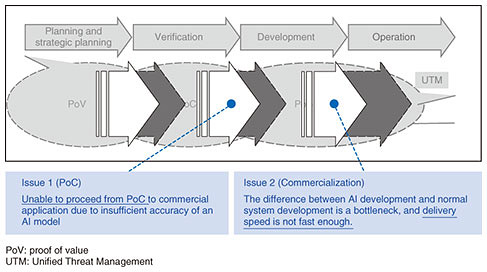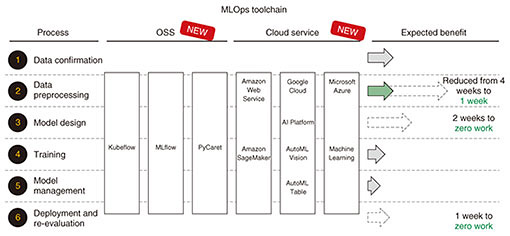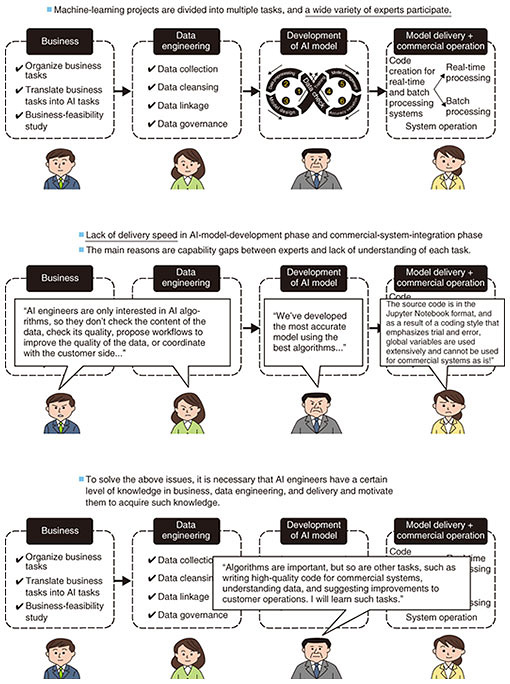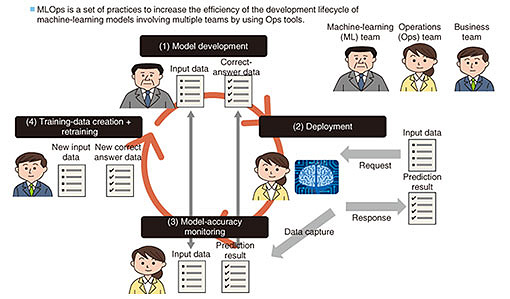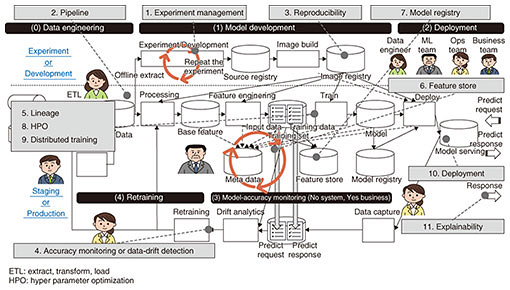 |
|
|
|
|
|
Feature Articles: ICT Solutions Offered by NTT Group Companies Vol. 19, No. 5, pp. 61–67, May 2021. https://doi.org/10.53829/ntr202105fa10 Speeding Up the Machine-learning Process with MLOps and Creating a Mechanism to Continuously Provide Service ValueAbstractMachine-learning operations (MLOps) is the machine-learning version of DevOps (development and operations) and represents the concept of how the people in charge of developing machine learning for a system and the people in charge of operating the system can collaborate to ensure smooth progress from implementation to operation of a commercial system. Recently, MLOps has been gaining in popularity; however, each vendor has a different definition of MLOps and there is no unified view. With that issue in mind, this article explains the background and basic concepts of MLOps as well as latest investigations and concrete means of implementing MLOps. Keywords: machine learning, MLOps, AI 1. BackgroundThe number of projects for launching new services or improving existing operations by using artificial intelligence (AI) is increasing yearly; however, there are many cases in which AI is not fully implemented in actual business. There are two main reasons for this state of affairs: (i) the accuracy of AI cannot be improved to a level that is sufficient for actual operations within a limited proof of concept (PoC) period and (ii) when the system developer takes over an AI model created by a machine-learning engineer and deploys it in a commercial system, it takes time to do it owing to the lack of communication and job splitting between them (Fig. 1).
Issues after service deployment include dealing with the phenomena of concept drift and data drift. For example, due to the spread of novel coronavirus (COVID-19) infections over the last year or so, people’s behavior has been changing on a weekly, or even daily, basis. Consequently, the accuracy of AI models fine-tuned by data scientists before the change has deteriorated over time, making the models useless. Such a phenomenon is referred to as concept (or data) drift. As a means of addressing the two issues shown in Fig. 1, a set of practices called machine-learning operations (MLOps) has recently been attracting attention. In this article, the approaches to use MLOps to address these issues are explained. 1.1 Issue 1: Unable to improve accuracy of an AI model to a level that can handle actual operations within the PoC periodTo address the first issue, it is considered effective to increase the number of tunings of an AI model within a limited PoC period by streamlining the tuning process. It seems intuitively correct that increasing the number of tunings will improve the accuracy of the model because doing so will incorporate many measures that may contribute to improved accuracy. Two steps are considered effective to make the tuning process, which is a mundane task, more efficient: first, standardize the process and give it a common language; second, introduce tools that can streamline each step of the process. For the first step, the analytical framework used in the data-analytics field is considered to be effective. For example, an analytical framework called CRISP-DM (cross-industry standard process for data mining) is available. This framework’s process is different from the waterfall development process in that it permits movement between processes in an agile manner (Fig. 2). CRISP-DM is compatible with the machine-learning development process in which it is common to improve accuracy of an AI model through trial and error by examining questions such as “What happens if we use such feature values?” and “What happens if we change the algorithm?”
For the second step, open source software (OSS), cloud-service providers, and third-party vendors have released tools to improve the efficiency of machine-learning development. NTT DATA is providing the following services for introducing MLOps to help customers having problems with efficiency of developing machine-learning models introduce tools that can improve the efficiency of each process (Fig. 3).
A tool called AutoML is a typical example of a very effective tool that can directly contribute to improving accuracy of machine learning. AutoML selects the most-accurate machine-learning model by simultaneously running multiple algorithms necessary in the machine-learning development process, namely, feature design, model design, and model tuning. However, even if these tools are used to improve the accuracy of AI, doing so will be meaningless unless the benefit to a customer’s actual business can be clearly shown. For that purpose, it is necessary to translate indicators of AI-model accuracy, namely, accuracy and recall rate, into the words used in the customer’s actual business so that the impact on their business is demonstrated. 1.2 Issue 2: Development of machine learning for commercial systems requires the cooperation of experts in various rolesAn overview of the machine-learning development process and roles of the participating experts is given in Fig. 4. Even at the overview level, the participation of a variety of experts is necessary. Many projects in which AI engineers and other experts participate face the following issues:
In light of these issues, it is clear that the definition of the role of AI engineers needs to be broadened in regard to the commercial-development phase. In addition to technical knowledge to improve model accuracy, which is essential in the PoC phase, there is a need for AI engineers who can create high-quality code for implementing commercial systems, understand data and customer operations, and make proposals for improving data quality. 1.3 Issue 3: When an event that changes people’s behavior occurs, such as a pandemic, machine-learning models that were tuned before the change become uselessCOVID-19 has spread rampantly around the world, and that situation has led to a change in people’s purchasing habits and the need for fingerprint authentication instead of face recognition on smartphones because people wear masks. This situation is an example of the phenomena known as concept drift and data drift, and it represents the problem that AI models created thus far have become useless because the statistical properties of the data generated change due to changes in people’s behavior. To deal with these phenomena, it is necessary to collect new data and rebuild the model with the collected data. However, it is inefficient to carry out that task manually every time this phenomenon arises; thus, it is necessary to automate the model-rebuilding process as a functional requirement and mechanism of the machine-learning system. In particular, for machine-learning models as well as general applications, the operation phase is crucial, and a mechanism for monitoring systematic error is not sufficient, that is, it is also necessary to monitor the accuracy of the machine-learning model. The overall process of MLOps is shown in Fig. 5. Not only (1) model development and (2) deployment but also (3) model-accuracy monitoring and (4) training-data creation + retraining are required. If these processes are introduced together with the automation mechanism, it will be possible to adapt to concept drift or data drift as a system.
2. Future developmentsMLOps is a recent technology trend, and the technology stack that underpins it, including definitions, is still immature. However, providers of OSS and cloud services as well as third-party vendors are working hard on developing MLOps tools and technologies, so it is necessary to continuously monitor these trends. Although an industry-wide consensus definition of MLOps has not yet been established, the information provided by vendors, including those overseas, on MLOps can be organized into a system structure (Fig. 6) and 11 functional groups (Table 1). Due to space limitations, we cannot explain each function listed in the table, but it is expected that MLOps tools will continue to mature, and the social implementation of AI will accelerate in proportion to that maturing. As such a trend continues, various pieces of expertise about social implementation of MLOps and AI will continue to be accumulated, and by using that expertise, NTT DATA wants to contribute to the development of the machine-learning industry and the social implementation of AI.
Trademark notesAll brand, product, and company names that appear in this article are trademarks or registered trademarks of their respective owners. |
|









